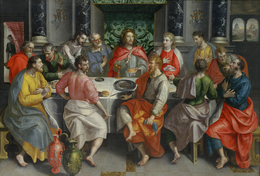Updated 28 February 2025
Currently not on display

Currently not on display
The Last Supper
| Materials and Techniques | oil on canvas |
|---|---|
| Size(cm) | 146 x 212.5 |
| Inscriptions | Signed lower right on the chair: F. M. D. Vos |
| Credit Line | Purchased |
| Category | Paintings |
| Collection Number | P.1992-0004 |
Marten de Vos was the most important Flemish painter active in the period linking Brueghel and Rubens. It is thought that de Vos lived in Italy during the 1550s, and there is some unproved supposition that he may have been active in Tintoretto's workshop. De Vos was primarily active in Antwerp and after a period as a Calvinist, from 1581-85, he returned to the Catholic faith. During this period in Antwerp the most important work for painters was the restoration of the various churches destroyed by the Calvinists, and such restoration work was closely linked to the Counter-Reformation religious movement. Himself a Lutheran, de Vos is thought to have painted works for wealthy merchants during the 1560s and 1570s, and inevitably the religious upheaval of the time led to his reversion to Catholicism. From the 1590s onwards he is known to have created a large number of altarpieces to adorn Catholic churches. Here de Vos used a traditional picture plane shape with the table placed almost horizontally in the space. Christ sits at the center of the far side of the table, with his disciples arrayed around him. When Christ announced that one amongst them had betrayed him, his disciples reacted visibly. This painting depicts that specific instant of reaction. Through various tricks of line of sight and placement de Vos arranged the disciples in small groups, and this compositional method ably isolates Judas the betrayer. While all the other disciples are either looking at Christ or are talking amongst themselves (there is one exception, looking out at the viewer, but that is a compositional device), it is only Judas, placed directly in front of Christ who turns strategically to the side to avoid Christ's gaze. However, regardless of the drama of the betrayal, the composition overall is quietly expressed in a subdued form. This quiet mood derives from the religious nature of the Last Supper. There are at least three images of the Last Supper known today by de Vos. (Source: Masterpieces of the National Museum of Western Art, Tokyo, 2009, cat. no. 25)
Provenance
Sale, Hôtel des ventes, Dijon, 18 November 1990; Didier Aaron, Paris; Purchased by the NMWA, 1993.
Exhibition History
- 1996
- The Crossing Visions: European and Modern Japanese Art from the Collections of The National Museum of Western Art & The National Museum of Modern Art, Tokyo, National Museum of Modern Art, Tokyo, 20 July 1996 - 8 September 1996, cat. no. 74
Bibliography
- 1992
- Didier Aaron Catalogue. Paris/London/New York, 1992, cat. no. 1.
- 1996
- Annual bulletin of the National Museum of Western Art. Nos. 27-28 (April 1992-March 1994), 1996, Nakamura, Toshiharu. New Acquisitions. pp. 13-19, List of New Acquisitions. p. 69, col. repr.
- 2006
- Masterpieces of The National Museum of Western Art, Tokyo. Tokyo, The National Museum of Western Art; Tokyo, The Western Art Foundation, 2006 (Japanese, preface in Japanese and English), no. 25, col. repr.
- 2009
- Masterpieces of The National Museum of Western Art, Tokyo. Tokyo, The National Museum of Western Art; Tokyo, The Western Art Foundation, 2009, no. 25, col. repr.
- 2013
- Masterpieces: The National Museum of Western Art, Tokyo. Tokyo, The Western Art Foundation, 2013 (Japanese, preface in Japanese and English), no. 24, col. repr.
- 2018
- Kofuku, Akira. Catalogue of Dutch and Flemish Paintings, The National Museum of Western Art, Tokyo. [Tokyo], The National Museum of Western Art, Tokyo; The Western Art Foundation, 2018, pp. 50-52, no. 10, col. repr.




